Raven in the South Island
February-March 2003
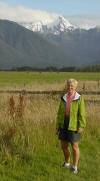
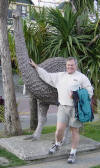 No,
we haven’t fallen off the edge of the earth. We’re alive and well and
living in a nice little rental house in Auckland, New Zealand. We’ve spent
three months living in New Zealand since Raven landed here in November
2002, and have come to love the country and its people. Here are some of
our latest adventures, especially our month-long car trip to New Zealand’s
beautiful South Island.
No,
we haven’t fallen off the edge of the earth. We’re alive and well and
living in a nice little rental house in Auckland, New Zealand. We’ve spent
three months living in New Zealand since Raven landed here in November
2002, and have come to love the country and its people. Here are some of
our latest adventures, especially our month-long car trip to New Zealand’s
beautiful South Island.
[Note: Click here for Raven’s South
Island travel ideas.]
America’s Cup
 Life
has started up again in New Zealand after the humiliating defeat in the
America’s Cup Races. The kiwis have taken it as a national affront to have
lost the Cup to the Swiss, especially since many of
Alinghi’s crew had been poached from Team New Zealand after the
last Cup. But you’ve probably read all about that.
Life
has started up again in New Zealand after the humiliating defeat in the
America’s Cup Races. The kiwis have taken it as a national affront to have
lost the Cup to the Swiss, especially since many of
Alinghi’s crew had been poached from Team New Zealand after the
last Cup. But you’ve probably read all about that.
 We
were lucky enough to go out on the race course with a wonderful family of
Texans we met on our South Island journey. They had chartered a 100+ foot
motor yacht for a year and invited us to join them for the racing. We
pounced on the invitation and really had a good time with them, their 13
year old daughter, her teacher and visiting family members, not to mention
the seven crew members. So there we were on three different race days (but
We
were lucky enough to go out on the race course with a wonderful family of
Texans we met on our South Island journey. They had chartered a 100+ foot
motor yacht for a year and invited us to join them for the racing. We
pounced on the invitation and really had a good time with them, their 13
year old daughter, her teacher and visiting family members, not to mention
the seven crew members. So there we were on three different race days (but
 saw
only one race because the weather was so uncooperative!) high
up on the sun deck of Askari, in the lap of
luxury, watching hundreds of boats focusing on two tall masts and what
they could do. It made the traffic jams of Fourth of July on Puget Sound
look like a picnic. We were very glad
we hadn’t taken Raven out into the
saw
only one race because the weather was so uncooperative!) high
up on the sun deck of Askari, in the lap of
luxury, watching hundreds of boats focusing on two tall masts and what
they could do. It made the traffic jams of Fourth of July on Puget Sound
look like a picnic. We were very glad
we hadn’t taken Raven out into the
 fray.
We also enjoyed the buzz of the Viaduct Basin, where all the race
syndicates were based and the superyachts are
docked. We have to admit to a bit of overindulgence in the commemorative
clothing department.
fray.
We also enjoyed the buzz of the Viaduct Basin, where all the race
syndicates were based and the superyachts are
docked. We have to admit to a bit of overindulgence in the commemorative
clothing department.
All in
all, we had a great time and feel like we were eyewitnesses to sailing
history. The weather during the whole series was strange, either flat calm
or blowing a gale. So racing on any chosen day was
 an
iffy situation. Then if we weren’t going out on
Askari, we had to finish all our boat jobs early we could glue
ourselves to the TV. Nothing much was accomplished by anyone in this
sailing-mad country for three weeks, as the TV coverage on race days
lasted from 9 am to 6 pm! Now everyone is scurrying to catch up, or
scurrying as much as Kiwis do. One of the pleasures here is that most
everyone is pretty laid back. In fact, it is not unusual to see people
walking around downtown in shorts or barefoot.
an
iffy situation. Then if we weren’t going out on
Askari, we had to finish all our boat jobs early we could glue
ourselves to the TV. Nothing much was accomplished by anyone in this
sailing-mad country for three weeks, as the TV coverage on race days
lasted from 9 am to 6 pm! Now everyone is scurrying to catch up, or
scurrying as much as Kiwis do. One of the pleasures here is that most
everyone is pretty laid back. In fact, it is not unusual to see people
walking around downtown in shorts or barefoot.
Raven “On the Hard”
NZ has a
huge cadre of skilled boat builders and technicians of all types, so all
cruisers arrive here with a big “NZ List” of jobs to be done. As I write,
our trusty Raven is hauled “on the hard” at Salthouse
Boatbuilders (highly recommended) for
maintenance work.
 She
looks like a plucked chicken: no sails, no mast, no cushions, no carpets,
just the bare bones. The boatyard is out in the sticks on a fast flowing
tidal river, surrounded by anchored cruising boats, ducks, and rowing
shells sculling by. It is quite bucolic despite the earsplitting Orion
radar planes flying at masthead height to land nearby at a Navy base.
Since the Orions are the planes that help
sailors in trouble, we just smile, wave and say, “Good on
ya!”
She
looks like a plucked chicken: no sails, no mast, no cushions, no carpets,
just the bare bones. The boatyard is out in the sticks on a fast flowing
tidal river, surrounded by anchored cruising boats, ducks, and rowing
shells sculling by. It is quite bucolic despite the earsplitting Orion
radar planes flying at masthead height to land nearby at a Navy base.
Since the Orions are the planes that help
sailors in trouble, we just smile, wave and say, “Good on
ya!”
South Island Cruise
Our big
travel news since we last updated this webpage is our month long car trip
to the South Island. If you haven’t been to New Zealand yet, put it on
your list. The scenery is spectacular (yes,
 the
scenery in Lord of the Rings movies is for real), and the natives
are overwhelmingly friendly. If you can
wangle a month’s tour, there is a ton to see just in the South Island.
Then leave another month for the North Island. You won’t be disappointed.
You also need plenty of driving time, since there are no motorways to
speak of and there are lots of twisty roads and one-lane bridges, but that
is all part of the charm. We put 5,000 km. on the car during this trip.
the
scenery in Lord of the Rings movies is for real), and the natives
are overwhelmingly friendly. If you can
wangle a month’s tour, there is a ton to see just in the South Island.
Then leave another month for the North Island. You won’t be disappointed.
You also need plenty of driving time, since there are no motorways to
speak of and there are lots of twisty roads and one-lane bridges, but that
is all part of the charm. We put 5,000 km. on the car during this trip.
We started
our trip with a short revisit to Lake Taupo,
then spent a couple days discovering
Wellington, the capital of the country. They have an amazing national
museum there called Te Papa, full of Maori treasures, history, a special
Lord of the Rings exhibit, exhibits on various aspects of Kiwi society,
etc. We spent hours and only saw one floor. We’ll definitely go back.
Kiwi B&Bs
High among
the delights of our trip were the B&Bs where we
stayed, and especially their hosts. We decided that we needed some TLC
after making it across the Pacific, and we’re glad we did. Most were
beautiful private homes with one or two guest rooms, yummy breakfasts,
beautiful bed linens, all the comforts, plus some of the friendliest hosts
we’ve ever met. Most invited their guests for wine and conversation every
evening. They always had great recommendations of local spots to visit,
restaurants not to be missed, and a favorite B&B in the next town. Out of
seventeen different homes, there was only one that was slightly less than
wonderful. We felt pretty lucky.
 But
that’s the way it is down here. People really go out of their way to
please, and the country is very well set up for travelers. Each town has
its “I-Site” where you can get all kinds of travel advice, make
reservations for hotels, tours, travel, etc. There are thousands of
accommodations of different levels, from the cheap backpacker (pronounced
beck-peck-uh in fluent Kiwi) hostels to posh spots like
Huka Lodge that require a second mortgage. The
country is well served with intercity busses, but most tourists rent cars
or campervans. There were also quite a few intrepid bike
tourers. We were quite happy in our boring but
thoroughly reliable Toyota Camry.
But
that’s the way it is down here. People really go out of their way to
please, and the country is very well set up for travelers. Each town has
its “I-Site” where you can get all kinds of travel advice, make
reservations for hotels, tours, travel, etc. There are thousands of
accommodations of different levels, from the cheap backpacker (pronounced
beck-peck-uh in fluent Kiwi) hostels to posh spots like
Huka Lodge that require a second mortgage. The
country is well served with intercity busses, but most tourists rent cars
or campervans. There were also quite a few intrepid bike
tourers. We were quite happy in our boring but
thoroughly reliable Toyota Camry.
We took
the Lynx ferry from Wellington to the South Island. For those of you who
are wondering why we didn’t take Raven south, the Cook Strait between the
two islands is one nasty piece of water. And it gets worse as you sail
south. The reason that we met the folks from Askari
was that their crew was prevented by high winds and seas from delivering
the boat to them in Milford Sound as planned.
Blenheim and the Marlborough Sound
 Blenheim
and the Marlborough Sound area were excellent first stops on the South
Island: a warm sunny region known for
vineyards, fine wine, and beautiful bays and islands. We did a couple of
days of wine tasting, eating yummy meals and then taking walks to wear
some of it off. What a way to go!
Blenheim
and the Marlborough Sound area were excellent first stops on the South
Island: a warm sunny region known for
vineyards, fine wine, and beautiful bays and islands. We did a couple of
days of wine tasting, eating yummy meals and then taking walks to wear
some of it off. What a way to go!
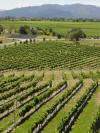 Even
though Signe had done plenty of research about what we wanted to see, we
still had no idea when we arrived whether to go clockwise or
anti-clockwise (as it is known down here) around the island. Our friendly
hosts at Karere House made lots of good
suggestions and set us up to go anti-clockwise, setting us up with an
itinerary of vineyards, restaurants, scenic spots, etc for the next
thousand kilometers.
Even
though Signe had done plenty of research about what we wanted to see, we
still had no idea when we arrived whether to go clockwise or
anti-clockwise (as it is known down here) around the island. Our friendly
hosts at Karere House made lots of good
suggestions and set us up to go anti-clockwise, setting us up with an
itinerary of vineyards, restaurants, scenic spots, etc for the next
thousand kilometers.
 We
started our experience of twisty roads with Queen Charlotte Drive from
Picton to Nelson. If you get car sick, take
the longer, straight road around!
There are spectacular views over Marlborough
We
started our experience of twisty roads with Queen Charlotte Drive from
Picton to Nelson. If you get car sick, take
the longer, straight road around!
There are spectacular views over Marlborough
 Sound,
but the passenger had to describe the view
to the driver, lest he miss a sudden
switchback.
Sound,
but the passenger had to describe the view
to the driver, lest he miss a sudden
switchback. For a lunch break we tried our first of the national specialty, green
lipped mussels. There is a funky restaurant in Havelock called The Mussel
Boys that fixes them about ten different ways. Yum!
For a lunch break we tried our first of the national specialty, green
lipped mussels. There is a funky restaurant in Havelock called The Mussel
Boys that fixes them about ten different ways. Yum!
Nelson is
a very artsy town with lots of craft galleries, one of the best bead shops
I’ve ever seen and a museum called The World of Wearable Art, or WOW. And
it was! Every year there is a show with artists invited to design costumes
on several different themes. What talent and creativity! I was totally in
my element, but Jan was just grateful there was a car museum next door!.
Rugged West Coast
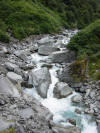
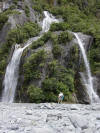 On
to the convoluted West Coast, to Westport, passing through the
Buller River Gorge. This was the first
of a series of deep rocky chasms with rushing rivers. The chief attraction
to my daredevil of a husband was the Buller
River Swing Bridge and Comet Ride. Now the Kiwis will do anything for a
thrill and the legal community does not have quite the sway that it does
in the US. This bridge was basically made of planks with chicken wire
along the sides. It was definitely not wide enough to let two people pass
On
to the convoluted West Coast, to Westport, passing through the
Buller River Gorge. This was the first
of a series of deep rocky chasms with rushing rivers. The chief attraction
to my daredevil of a husband was the Buller
River Swing Bridge and Comet Ride. Now the Kiwis will do anything for a
thrill and the legal community does not have quite the sway that it does
in the US. This bridge was basically made of planks with chicken wire
along the sides. It was definitely not wide enough to let two people pass
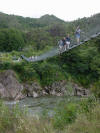 comfortably.
Access was theoretically limited to fourteen people at a time, but I swear
I counted at least twenty joining my crossing. What were they thinking!!!
As we swayed back and forth, there was a ton of rushing river water about
a hundred yards below me. Are you getting the feeling that this was not my
favorite experience of the trip? Not to be outdone, though, Jan had to
take the Comet Ride back across. He
was harnessed in a swing seat and the
Kiwi jokester-attendant shoved him
out onto
comfortably.
Access was theoretically limited to fourteen people at a time, but I swear
I counted at least twenty joining my crossing. What were they thinking!!!
As we swayed back and forth, there was a ton of rushing river water about
a hundred yards below me. Are you getting the feeling that this was not my
favorite experience of the trip? Not to be outdone, though, Jan had to
take the Comet Ride back across. He
was harnessed in a swing seat and the
Kiwi jokester-attendant shoved him
out onto
 the
cable, saying, “Oh, wait! I didn’t
tell you how to do the landing!” When he landed, he said he regretted not
doing it in the Superman Position, like the teenagers were: more fun, and
only a slight surcharge!
the
cable, saying, “Oh, wait! I didn’t
tell you how to do the landing!” When he landed, he said he regretted not
doing it in the Superman Position, like the teenagers were: more fun, and
only a slight surcharge!
 The
coast at Westport looks a lot like the Oregon coast, very wind swept and
rainy with waves crashing impressively on the rocks. In fact we had the
biggest downpour of the trip and were glad for all our Northwest rain
gear. Most of the building roofs here are metal, so hearing the rain
beating on the roof all night was quite pleasant.
The
coast at Westport looks a lot like the Oregon coast, very wind swept and
rainy with waves crashing impressively on the rocks. In fact we had the
biggest downpour of the trip and were glad for all our Northwest rain
gear. Most of the building roofs here are metal, so hearing the rain
beating on the roof all night was quite pleasant.
 One
of the scenic areas on the way south is Pancake Rocks. We were still a bit
skeptical about some of these “tourist spots”, but Pancake Rocks were
geologically fantastic, with huge blowholes and rock arches. We enjoyed it
even in the pounding rain.
One
of the scenic areas on the way south is Pancake Rocks. We were still a bit
skeptical about some of these “tourist spots”, but Pancake Rocks were
geologically fantastic, with huge blowholes and rock arches. We enjoyed it
even in the pounding rain.
 Our
B&B that night, Kapitea Lodge was a huge house
on a cliff over the sea. They had five rooms that were all occupied. One
of the problems of the West Coast is that there aren’t many restaurants,
so we had arranged to have dinner there, as had all the other guests. We
had a rollicking dinner party with new friends from the UK, Holland,
Ireland and Canada, and a good dinner besides.
Our
B&B that night, Kapitea Lodge was a huge house
on a cliff over the sea. They had five rooms that were all occupied. One
of the problems of the West Coast is that there aren’t many restaurants,
so we had arranged to have dinner there, as had all the other guests. We
had a rollicking dinner party with new friends from the UK, Holland,
Ireland and Canada, and a good dinner besides.
 The
next day we stopped to see Fox and Franz Josef Glaciers, and Mt. Cook. The
mountains in that part of the coast are known as the Southern Alps and
they are really impressive. The snouts of the glaciers are within walking
distance of the roads, so we enjoyed being up close and personal – again
something that wouldn’t be
The
next day we stopped to see Fox and Franz Josef Glaciers, and Mt. Cook. The
mountains in that part of the coast are known as the Southern Alps and
they are really impressive. The snouts of the glaciers are within walking
distance of the roads, so we enjoyed being up close and personal – again
something that wouldn’t be
 permitted
in our litigious society. In the parking lot we spied two keas, the
fearless and intelligent local parrots whose favorite recreation is
pecking the rubber moldings around car windshields, but escaped before
they got to our car!
permitted
in our litigious society. In the parking lot we spied two keas, the
fearless and intelligent local parrots whose favorite recreation is
pecking the rubber moldings around car windshields, but escaped before
they got to our car!
Wanaka
and Queenstown
 From
the coast we headed inland through gold rush country to
Wanaka, a small ski and summer resort town on
a big lake. We did a bit of hiking there and had a river kayaking
experience. I was
From
the coast we headed inland through gold rush country to
Wanaka, a small ski and summer resort town on
a big lake. We did a bit of hiking there and had a river kayaking
experience. I was
 nervous
about the whole thing, but our kayaking from Raven served us well. The
first rapids gave me a nasty little wave over the bow – and tossed Jan
into the swiftly flowing river. Admittedly he was in an open kayak, tough
to steer, and he claims he really enjoyed the refreshing mountain water!
The guides helped him back in and we floated and paddled our way down
river. It was a gorgeous day with poplar trees lining a river that was so
clear we could see the trout swimming by.
nervous
about the whole thing, but our kayaking from Raven served us well. The
first rapids gave me a nasty little wave over the bow – and tossed Jan
into the swiftly flowing river. Admittedly he was in an open kayak, tough
to steer, and he claims he really enjoyed the refreshing mountain water!
The guides helped him back in and we floated and paddled our way down
river. It was a gorgeous day with poplar trees lining a river that was so
clear we could see the trout swimming by.

 Queenstown,
also a ski and resort town on a lake, was next. We stayed in a super
modern house, Twin Peaks, built on a high rock overlooking the mountains
and the lake. Queenstown is known as the Adventure Capital of New Zealand.
Kiwis will do anything as long as it involves jumping off of or out of
something! There were plenty of opportunities to go
bungy jumping, canyoning, tandem
skydiving,
Queenstown,
also a ski and resort town on a lake, was next. We stayed in a super
modern house, Twin Peaks, built on a high rock overlooking the mountains
and the lake. Queenstown is known as the Adventure Capital of New Zealand.
Kiwis will do anything as long as it involves jumping off of or out of
something! There were plenty of opportunities to go
bungy jumping, canyoning, tandem
skydiving,
 sledging
(whitewater kayaking without the kayak), parasailing,
zorbing (don’t’ ask!), etc. We had no trouble restraining ourselves
to a cable car and a luge ride down the
mountain. Of course we also had to do the famous
Shotover Jetboat ride. Imagine going
about 60 miles an hour in a rushing river, coming within centimeters of
the canyon walls, then doing 360 degree turns into
sledging
(whitewater kayaking without the kayak), parasailing,
zorbing (don’t’ ask!), etc. We had no trouble restraining ourselves
to a cable car and a luge ride down the
mountain. Of course we also had to do the famous
Shotover Jetboat ride. Imagine going
about 60 miles an hour in a rushing river, coming within centimeters of
the canyon walls, then doing 360 degree turns into
 the
rapids. We also flashed over areas of the river where the water
was about four inches deep. I was sure we
would be flying end over end. It was a not-to-be-missed
experience for both of us. On a
the
rapids. We also flashed over areas of the river where the water
was about four inches deep. I was sure we
would be flying end over end. It was a not-to-be-missed
experience for both of us. On a
 calmer
note, we had a peaceful outing on the lake on a 1900’s steam ship called
the Earnslaw to a sheep station where we saw a
display of sheep shearing and herding by sheep dogs.
calmer
note, we had a peaceful outing on the lake on a 1900’s steam ship called
the Earnslaw to a sheep station where we saw a
display of sheep shearing and herding by sheep dogs.
Doubtful Sound Cruise
 There
is a whole area of the West Coast that is isolated with sounds and fjords
galore. We decided to take an small ship on an
overnight tour of Doubtful Sound (Captain Cook gave some wonderful names
to places he visited!). Milford Sound is better known, but is now full of
helicopter sightseeing flights and lots of tourists, so it has been a bit
ruined according to many of our B&B hosts. We are not generally interested
in group touring, but the ship was the only option. So by a very
circuitous, but fascinating trip by bus, ferry, another bus and finally
our ship, we arrived in Doubtful Sound. We had a small, but comfortable
cabin, excellent food; knowledgeable nature guides; and friendly
passengers from all over
There
is a whole area of the West Coast that is isolated with sounds and fjords
galore. We decided to take an small ship on an
overnight tour of Doubtful Sound (Captain Cook gave some wonderful names
to places he visited!). Milford Sound is better known, but is now full of
helicopter sightseeing flights and lots of tourists, so it has been a bit
ruined according to many of our B&B hosts. We are not generally interested
in group touring, but the ship was the only option. So by a very
circuitous, but fascinating trip by bus, ferry, another bus and finally
our ship, we arrived in Doubtful Sound. We had a small, but comfortable
cabin, excellent food; knowledgeable nature guides; and friendly
passengers from all over
 the
world. The scenery was very much like Alaska, but with different
vegetation and wildlife. The one form of wildlife that we could have done
without was the ravenous sand flies. They were in swarms around us anytime
we were on land. They bite, but you don’t realize you’ve been attacked
until two days later when the itching starts. We made several trips to
pharmacies to find a cure. If you go – be warned!
the
world. The scenery was very much like Alaska, but with different
vegetation and wildlife. The one form of wildlife that we could have done
without was the ravenous sand flies. They were in swarms around us anytime
we were on land. They bite, but you don’t realize you’ve been attacked
until two days later when the itching starts. We made several trips to
pharmacies to find a cure. If you go – be warned!
On this
trip we became connoisseurs of the altered road sign, a New Zealand
specialty. We wish we had stopped to take photos, but you’ll just have to
take our word for these examples of Kiwi humor. One sign that started out
as “Danger-Ice” ended up as “Danger Spice Girls.” Another started out as a
pedestrian crossing and ended up as a billiards player. The best, though,
showed that there were a couple of bumps ahead in the road – someone had
added a very professional set of nipples.
Dunedin and
Oamaru
 From
Queenstown we headed for the East Coast and Dunedin, which had been the
wealthiest city in New Zealand during the Gold Rushes of the 1860’s. The
lavish architecture, especially the banks, the train station and some of
the stately homes showed just how much gold had passed through the city.
From
Queenstown we headed for the East Coast and Dunedin, which had been the
wealthiest city in New Zealand during the Gold Rushes of the 1860’s. The
lavish architecture, especially the banks, the train station and some of
the stately homes showed just how much gold had passed through the city.
The
Dunedin Peninsula is really spectacular with rolling farm lands
alternating with views of the sea. The highlight, though, was a visit to
the royal albatross colony, the world’s only accessible albatross
nesting site. The birds were still nesting
and, from the viewing blind, we were able to see some big chicks
covered in fluffy white down and several eggs that were still in the
nests. The Royal Albatross is a huge bird with a wing span of about ten
feet. When one flies over, it is an amazing sight. The nestlings and eggs
are carefully guarded by rangers who set traps for predators (they caught
32 weasels last season!), watch over the eggs and chicks, and generally
make sure these endangered birds keep reproducing.
 We
continued our travels north up the coast to Oamaru,
which turned out to be a hidden gem. A pair of architects designed 30 or
so buildings there in the 1880’s (gold, wool, and grain profits!) out of
the beautiful, white local sandstone. Most of New Zealand is pretty
nondescript architecturally, but here in the middle of nowhere were all
these fabulously decorated buildings, all glowing in the sun.
We
continued our travels north up the coast to Oamaru,
which turned out to be a hidden gem. A pair of architects designed 30 or
so buildings there in the 1880’s (gold, wool, and grain profits!) out of
the beautiful, white local sandstone. Most of New Zealand is pretty
nondescript architecturally, but here in the middle of nowhere were all
these fabulously decorated buildings, all glowing in the sun.
 Apparently,
after the Gold Rush, the bottom dropped out
of the
economy, people moved away and no one wanted to take the old buildings
down to make way for something in a more modern style. How fortunate!
Apparently,
after the Gold Rush, the bottom dropped out
of the
economy, people moved away and no one wanted to take the old buildings
down to make way for something in a more modern style. How fortunate!
In
Oamaru we had more wildlife adventures
watching the little blue penguins come back to their nests for the night.
They go out hunting alone for several
days, then form into groups for protection
 to
come back ashore. They surfed the waves up onto
the rocky shore, and then slowly waddled up to the road, where they
patiently stood until they were sure the coast was clear. Then they dashed
across to their nests and their waiting babies.
to
come back ashore. They surfed the waves up onto
the rocky shore, and then slowly waddled up to the road, where they
patiently stood until they were sure the coast was clear. Then they dashed
across to their nests and their waiting babies.
Christchurch
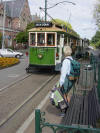 Our
last major stop was Christchurch where we discovered the Antarctic Center,
the base for all the NZ and US Antarctic expeditions. The visitors’ center
there was full of intriguing displays and videos of life on the bases.
Imagine spending an Antarctic winter in the bitter cold with no daylight
at all for months on end. Give me the tropics anytime!
Our
last major stop was Christchurch where we discovered the Antarctic Center,
the base for all the NZ and US Antarctic expeditions. The visitors’ center
there was full of intriguing displays and videos of life on the bases.
Imagine spending an Antarctic winter in the bitter cold with no daylight
at all for months on end. Give me the tropics anytime!
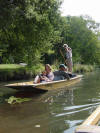 Christchurch
is a very lovely city with the River
Christchurch
is a very lovely city with the River
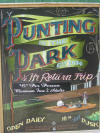 Avon
running through it. It makes for a very peaceful atmosphere, especially
when viewed from a river boat floating along under the trees. There is
also a big botanical garden and a fine museum in the center of the city.
There is not a lot to do in Christchurch other than to hang out and enjoy
its beauty.
Avon
running through it. It makes for a very peaceful atmosphere, especially
when viewed from a river boat floating along under the trees. There is
also a big botanical garden and a fine museum in the center of the city.
There is not a lot to do in Christchurch other than to hang out and enjoy
its beauty.
As we
headed farther north up the coast, there were fewer towns and more
beautiful coastline. We had our hearts set on a big meal of the lobster
that the area is known for, but had a terrible time finding any, as most
are shipped live to Japan. The ones that remain must, by NZ law, be
drowned slowly in fresh water before being boiled – this is allegedly more
humane! The restaurant where this torture was explained to us then wanted
to grill the already-cooked lobster before serving it. Rather than spend a
fortune for some overcooked seafood, we went to the landing pier and
bought some crayfish that had merely been steamed,
then took them to our next B&B to eat chilled for our last dinner
in the South Island. It was a fitting culinary end to a great trip.
We have
just returned from a trip to the US to help Paul and Michelle settle into
their new home in LA, and to go to a baby shower. We are really having fun
perfecting our grandparenting techniques in
advance. Jan was caught checking out the stuffed animal department and
succumbed to a tiny pair of NZ wool booties for the baby the other day.
Now we are
back and settled into our cute furnished rental house, while Raven is
groomed at the boatyard. We are enjoying the delights of having a washer
and dryer, a dishwasher, comfy chairs and lots of room to spread out. We
will definitely do some touring in the North Island before going back to
the US in June to await our first grandbaby’s arrival. Hope to see you
then.
Love . . .
Signe and Jan
PS: If you
want to travel to NZ’s South Island, take a
look at our page of [Raven’s South
Island Picks] for some travel ideas and recommendations.